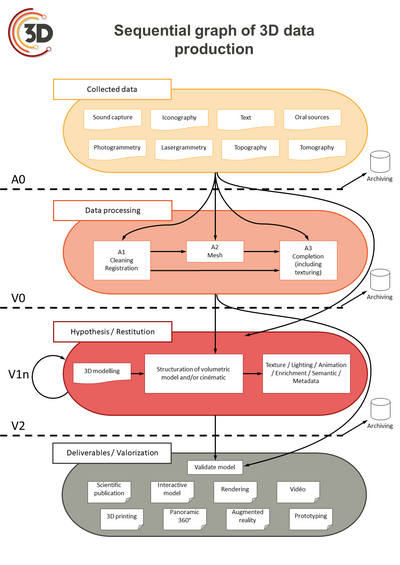Difference between revisions of "Workflow:Life Cycle of 3D Data for Cultural Heritage"
| Line 92: | Line 92: | ||
<!-- Describe what your workflow is for - i.e. what it is designed to achieve, what the organisational context of the workflow is, and what content it is designed to work with --> | <!-- Describe what your workflow is for - i.e. what it is designed to achieve, what the organisational context of the workflow is, and what content it is designed to work with --> | ||
It presents the steps of the production process in a simplified way. The system of the graph has been defined to follow a logical path with notably the use of loops to express the recursive aspect of the work on data, especially during the hypothesis and restitution stages. | It presents the steps of the production process in a simplified way. The system of the graph has been defined to follow a logical path with notably the use of loops to express the recursive aspect of the work on data, especially during the hypothesis and restitution stages. | ||
| + | In a 3D restitution process: which data may be archived? | ||
| + | This workflow defines different steps in the creation of 3D data in humanities and social sciences. | ||
| + | It identifies how and when 3D data is produced. | ||
| + | It chooses 3D data for archiving. | ||
== Context== | == Context== | ||
Revision as of 10:11, 23 February 2022
Workflow Description
The steps are:
- A0: acquired data
- V0: processed data
- V1n: hypotheses and restitutions loops and options
- V2: approved restitutions
Each step may be archived independently. The AIP should be properly linked.All steps may be gathered in a single archive.
A0 - Raw data - Archived
A0 = raw acquired data For example:
| Process | Data | File type |
|---|---|---|
| Photogrammetry | 2D color pictures | tiff, dng, ... |
| Lasergrammetry | point-cloud | ply ASCII, ... |
| Tomography | shades of grey 2D picture+ descriptions | ANALYZE (hdr + img), DICOM |
| Archives / historical sources | 2D pictures, texts, sound, 3D ... | png, jpg, pdf, ogg, ply, |
| Other | GPS data, color calibration target, acquisition process | txt |
V0 - Processed data - Archived
V0 = A0 + basic human action + software processThis is the first 3D validated by a human.
It may have been:
- cleaned
- assembled
- meshed
- holes filled
- textured
For example:
| Process | VO |
|---|---|
| Photogrammetry | mesh or the point-cloud based on the pictures only.With human choices for parameters and manual cleaning, selecting points, georeferecencing, etc. |
| Lasergrammetry | cleaned point-cloud, meshed, georeferenced, etc. |
| Tomography | - |
| Archives / historical sources | V0 doesn’t exist |
V1n - Restitutions - NOT archived
V1n = v0 + human knowledge V1n means: v1a, v1b, v1c, ... These are the restitution steps or options.It includes humanity knowledge contribution (archeological, historical, medical, etc.). They are working data , options and trials. These loops express the recursive aspect of the work with hypothesis and restitution stages.
It may have been:
- semantically enriched
- completed (missing parts)
- animated
V2 - Approved restitutions - Archived
V2 = scientifically approved V1n I concerns the approved options developed in V1n. I may be approved by any scientific committee. In the best case it is related to an article.
Purpose
It presents the steps of the production process in a simplified way. The system of the graph has been defined to follow a logical path with notably the use of loops to express the recursive aspect of the work on data, especially during the hypothesis and restitution stages. In a 3D restitution process: which data may be archived? This workflow defines different steps in the creation of 3D data in humanities and social sciences. It identifies how and when 3D data is produced. It chooses 3D data for archiving.
Context
This workflow has been developed by the “3D Consortium for humanities”, part of Huma-Num, the french institution for digital humanities. It was initially designed for archeology, and is now open to any humanity field.
Evaluation/Review
Applied workflow in all team of the french consortium for 3D. This workflow is being updated to work with fields of humanities others than cultural heritage.
Further Information
Xavier Granier, Laurent Bergerot, Mehdi Chayani, Bruno Dutailly, Pascal Mora, et al. 3D lexicon for Human and Social Sciences. Recommendations of the "Consortium 3D for Humanities", 2021. ⟨hal-03187979⟩
Xavier Granier, Laurent Bergerot, Mehdi Chayani, Bruno Dutailly, Pascal Mora, et al. 3D lexicon for Human and Social Sciences. Recommendations of the "Consortium 3D for Humanities", 2021. p 6 ⟨hal-03187979⟩
Bruno Dutailly, Sylvie Eusèbe, Valentin Grimaud, Nicolas Lefèvre, Mathieu Quantin, et al.. Life cycle of 3d data for cultural heritage: Identify how and when 3D data is produced. Choose 3D file formats for archiving. Define a robust process for producing 3D data and preserving it. Visual Heritage 2018, Nov 2018, Vienne, Austria. ⟨hal-01926434⟩
